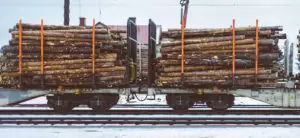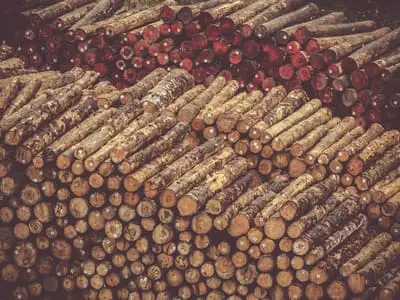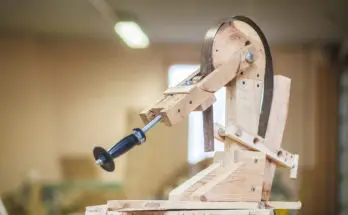If you look around in your home, you will likely be surprised at how much stuff is made from wood. There’s the obvious things like your furniture, but there’s also bowls, pens, flooring, staircases, cabinets, toothpicks, broomsticks, rolling pins and that’s just to name a few. But another question to ask is, HOW did these items become what they are? At some point, these items were apart of a tree that had been growing in a forest for decades. Turning trees into lumber is a thorough process. It’s also a very dangerous process that we will discover below.
Logging Industry
History
The first step in turning a tree into a piece of lumber begins at the logging stage. Logging is defined as the process of cutting down trees in order to transport the logs to a sawmill or lumber company. Logging in the United States began not long after the first settlers arrived to their new frontier. In order to survive the harsh winters that the settlers faced, they needed to cut trees and prepare them into workable logs in order to build shelter.
Nowadays, logging has morphed into a multi-billion dollar industry. It’s estimated that the logging industry brings in $16 Billion dollars of revenue per year in the United States.
Safety
Working in the logging industry is one of the most dangerous career choices one can make. According to a study by the CDC, there were 95,000 workers in the industry in 2010. During the year, the industry accounted for 70 deaths. These stats indicate the death rate for a logging worker to be 74 per 100,000 people. This is 21 times the normal fatality rate of a U.S. citizen.
Though the risk of injury or death is high in the logging industry, workers are not compensated for this risk. The average income of a logger is about $40,000 a year which is less than the overall average salary of a US worker of $44,000.
Driving
One trees have been cut down, the next step in the process is to get the logs out of the forest and then transport them to a sawmill. This process is sometimes referred to as “driving.” Prior to heavy machinery, the primary method for moving cut trees out of the forest was by horse and ox.

Once the logs were out of the forest, the quickest method at the time was to float the logs down rivers. This was often referred to as “log driving.”
As the Industrial Revolution began, the transportation of logs became much easier due to the increase usage of the railroad system within the United States.
Trains are still used as a mode for transportation for logs nowadays, though the increase in diesel trucks has become the go to method in the industry.
Manufacturing
Debarking
To this point in the process, there has been very little to change the actual look of the timber. That all changes once it reaches the saw mill. Once a log enters the mill, the first stop is at the debarking machine. Depending on the saw mill, and the type of wood, there are 3 primary types of machines that can be used to debark a log. They are referred as drum debarking, rotary debarking, or the ring cutting.
- Drum Debarking – In this method, several logs are loaded into a massive metal cylinder. Once loading is complete, it begins spinning, thus causing the logs to burn against one another as well as the metal grates on the machine. Over time, this wears down the bark on the trees
- Rotary Debarking – This method somewhat resembles a wood lathe. The log is loaded into a cradle that rotates quickly as a knife moves up and down the length of the log thus cutting away the bark.
- Ring Cutter – This machine has large round blades that the log passes through. As the log passes through the blades, the bark is cut away. This scenario is most often referred to as the “pencil sharpener” method.
Sawing
After the debarking process has been completed, the logs are sorted by a variety of different methods. Some of the characteristics that the head sawyer (person in charge of the sawmill) are looking for include: species of wood, length, knots present and overall quality of the wood. Once sorted, the log begin to be cut down into the sizes the sawyer has decided upon. Logs can go through this process several times depending upon the log size and the desired size of the lumber.

At this point, the logs have been cut down into lumber. The lumber boards will now move to the next phases that are referred to as edging, trimming and planing. Edging and trimming are making sure the boards are cut with clean straight sides, while planing is used to cut the boards to their desired thicknesses.
Once the boards have finished this step, they’re ready for transport to a buyer that will have them on their way to becoming a product in your home.
Sawmill Waste
Transforming a log into lumber is impossible without waste. In order to end with a board that is straight and squared, a sawmill has to cut and trim the wood numerous times in the process. Interestingly, the amount of true waste in the saw milling process is very small. Mills collect the waste and scaps at each stage of the production process. The waste is then sold to landscapers, paper mills, or farmers for use in their facilities.
How much lumber comes from a tree?
The amount of lumber that is contained in a single tree can vary, however, there are calculations available to provide an estimate. The height and the diameter of the tree are used to calculation the board feet contained within a tree. A tree that can produce a log that is 15 feet in length and has a diameter of 10″ can product approximately 34 board feet. To compare, the board feet for a 15 foot tree increases to 634 board feet when the diameter increases to 30″.
How much does a log sell for?

The value of a log is based on a wide variety of factors. Geographical location, the amount of sap, species of wood, rarity of species, size, color and the debris in the wood can all have significant impact on the price someone is willing to pay for a log.
Logs are typically sold in price per board foot. Prices can range from .50 per BF to $2.00+. Therefore, the 30″ diameter tree that we used as an example above could sell for between $300 and $1250 based on some of the factors we listed above.
Top State Producers of Lumber?
Over the past 5 years, the United States has produce about 40 million board feet of timber per year. Currently the major lumber producers in the United States are Washington, Oregon and California due to their vast forests.
How long to regrow trees from logging?
Reforestation is the act of replanting trees after logging has occurred. As concerns for climate control have grown, so has the focus on reforesting correctly after logging has taken place. Most major companies have programs in place to plant new trees upon the completion of a logging project. However, it can take years before the land recovers. It’s estimated that it will take 30-50+ years for trees to return to normal mature heights once logging has taken place.
Will we run out of trees due to logging?
According to AppalachianHardwoods.org, they estimate that approximately one third of the United States is covered by trees. That’s  about 728 million acres. According to their research, we have approximately 70% of the trees right now as compared to what was present when Christopher Columbus arrived.
about 728 million acres. According to their research, we have approximately 70% of the trees right now as compared to what was present when Christopher Columbus arrived.
So even after centuries of logging, there’s only been a slight decline in the amount of trees. This is impressive given the population of the United States is approximately 326 million people. It’s important that logging companies continue to pursue ways to increase the success rate of reforestation projects. This will be vital in keeping our environment healthy and the population continues to increase which will increase the demand for logging and timber.




